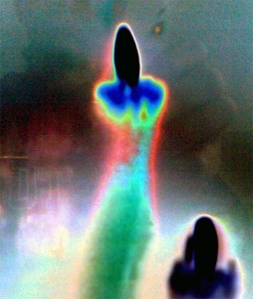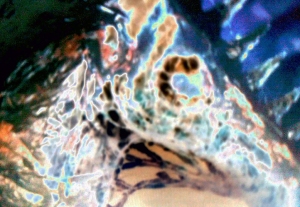I just saw “Visions of ecstasy” directed by Nigel Wintrope. A short film which has a few claims to fame; the main being that it is the only film that has been banned in England on the sole grounds of blasphemy.
The film is indeed a short film, and without dialogue.
Now having seen it I can surely understand the desire and action for why it was banned. It is a highly erotic film with a focus on sexual fantasies between a nun and a dead Christ still attached to his cross. Apart from this it also features the standard “Nunsplotation”. However, the scenes that really create the most effect are the scenes between the nun and Christ.
What really makes me understand the reason for imposing censorship is that the erotic scene are also very connected to more approved scenes of worship. What I relate to here is the kissing of the feet and the admiration of Christs sacrifice on the cross. It is similar to scenes of worship available in books, icons, movies and photography that is approved and supported by the church. Christ in this film also has the typical characteristics of the final sacrifice. He is crucified, has the crown of thorns and the “christ” look that is quite easily recognized from paintings, Hollywood films etcetera. Also, he carries all the stigmata that are mentioned.
The scenes of worship that could easily be accepted and approved by the church are mixed with a sexual content. The nun kisses and caresses the wounds and sits on top of the Christ who is attached to the cross on the floor. She is ecstatic and is enjoying her sexual experience. Also, she kisses the Christ.
So, there are quite explicit scenes of a nun performing sexual rites with the Christ. It is not quite clear if he is dead or still alive; so there is also the added possibility of necrophilia. Here we have nunsplotation and a sex scene with the Christ.
The film has a context of a sexual fantasy; as it is set up as a imagination of the nun. Still, there is absolutly sinful acts performed if seen from a christian context. There are several taboos that are broken and displayed. The scenes that work from a pious scenes only expands the sinful nature.
I can draw references to Martin Scorseces “The last temptation of christ”. In that movie it is the Christ that imagines a normal life with wife and children while hanging on the cross. This film also drew a lot of controversy on release and was widely discussed (and still is).
“Visions of ecstasy” was made in 1989 but did not become available to see for a wide audience until 2012. The ban lasted a long time, and also the debate.
As mentioned above I do understand the debate and the reasons for advocating censorship here. It is obviously a sexual film and quite “blasphemous”. I can also relate to the debate regarding the Muhammed movie and the debate in Sweden around “Ecce Homo” that portraited Jesus with men who had typically gay attributes.
The film in itself is very artistic and has a good soundtrack. There is a obvious late 80´s touch when it come to hairstyles, but the images are skillfully carried out. The camerawork is efficient and the acting quite good. It could use some change in editing but all in all it is a artistic, good film.
As for the debate, this is one way to challenge religion and discuss it. To ban is to arise interest. To scream for censorship also arises interest. A secret book, a banned book or a hidden picture that cannot be seen wakes the effort to experience. Man has an interest in finding out what is unknown and try to figure it out. A curious nature. Without it, science would not progress and religion would be very static.
But man is everchanging, and so is the curious nature.
Also, things used to be; and now they are not.


Reblogged this on Synthfrisyr's Weblog and commented:
Visions of salvation